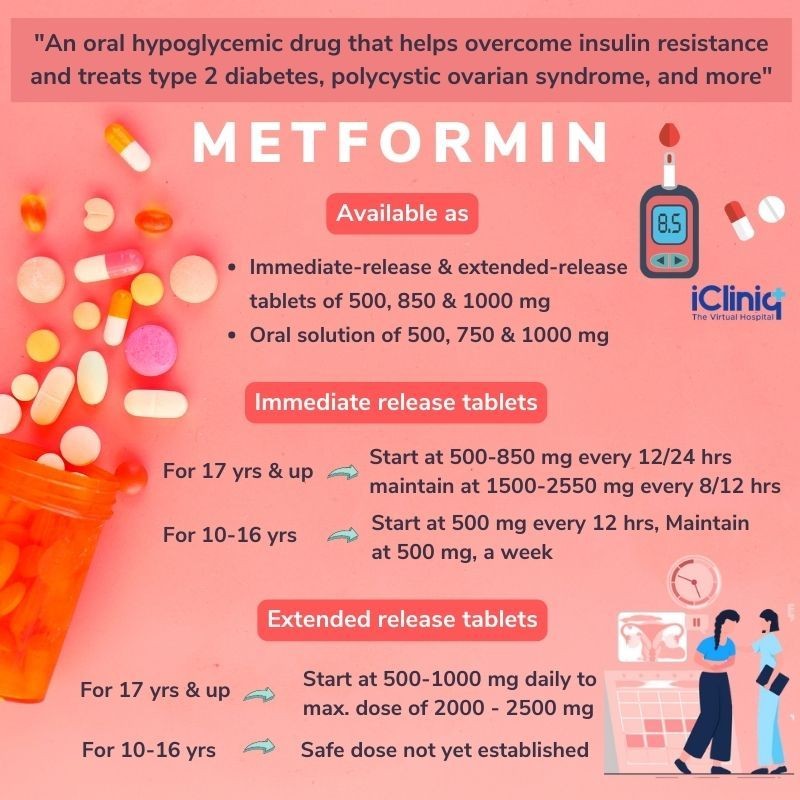
Contents
Metformin vs. Glucovance
These symptoms occur in one out of every three patients. These side effects may be severe enough to cause therapy to be discontinued in one out of every 20 patients. Side effects are related to the dose of the medication and may decrease if the dose is reduced.
Metformin may also cause:
- weakness,
- respiratory tract infections,
- low levels of vitamin B-12,
- low blood glucose,
- heartburn, and
- chills.
A serious but rare side effect of metformin is lactic acidosis. Lactic acidosis occurs in one out of every 30,000 patients and is fatal in 50% of cases. Symptoms of lactic acidosis are:
- weakness,
- trouble breathing,
- abnormal heartbeats,
- unusual muscle pain,
- stomach discomfort,
- light-headedness, and
- feeling cold.
Patients at risk for lactic acidosis include those with reduced function of the:
- kidneys or liver,
- congestive heart failure,
- severe acute illnesses, and
- dehydration.
Glucovance side effects
The most common side effects include:
Other commonly reported side effects with Glucovance therapy include:
- decreased appetite,
- metallic taste,
- gas,
- heartburn, and
- weight loss.
Other side effects include:
- hypoglycemia (low blood glucose),
- blood disorders,
- decrease blood sodium levels,
- rash,
- sensitivity to the sunlight,
- itching,
- liver disease,
- SIADH,
- hives, and
- hypersensitivity type reactions.
Metformin can cause a rare but serious condition known as lactic acidosis, a build-up of acid in the blood. Lactic acidosis can cause death and requires immediate treatment. Symptoms of lactic acidosis include:
- tiredness,
- weakness,
- unusual
- muscle pain,
- pain in the stomach,
- difficulty breathing,
- dizziness, and
- slow or irregular heartbeat.
Patients suspected of having signs of lactic acidosis must seek emergency medical help.
What is the dosage for metformin vs. Glucovance?
Metformin dosage
- For treating type 2 diabetes in adults, metformin (immediate release) usually is begun at a dose of 500 mg twice a day or 850 mg once daily. The dose is gradually increased by 500 mg weekly or 850 mg every two weeks as tolerated and based on the response of glucose levels. The maximum daily dose is 2550 mg given in three divided doses.
- If extended tablets are used, the starting dose is 500 mg or 1000 mg daily with the evening meal. The dose can be increased by 500 mg weekly up to a maximum dose of 2000 mg except for Fortamet (2500 mg of Fortamet, once daily or in two divided doses). Glumetza tablets (500 -1000mg formulations are given once daily (either 1000 to 2000mg). Fortamet and Glumetza are modified release formulations of metformin. Metformin should be taken with meals.
- For pediatric patients 10-16 years of age, the starting dose is 500 mg twice a day. The dose can be increased by 500 mg weekly up to a maximum dose of 2000 mg in divided doses.
- Children older than 17 years of age may receive 500 mg of extended release tablets daily up to a maximum dose of 2000 mg daily. Extended release tablets are not approved for children younger than 17 years of age.
- Metformin-containing drugs may be safely used in patients with mild to moderate renal impairment. Renal function should be assessed before starting treatment and at least yearly.
- Metformin should not be used by patients with an estimated glomerular filtration rate (eGFR) below 30 mL/minute/1.73 m2 and starting metformin in patients with an eGFR between 30-45 mL/minute/1.73 m2 is not recommended.
- Metformin should be stopped at the time of or before administering iodinated contrast in patients with an eGFR between 30 and 60 mL/minute/1.73 m2; in patients with a history of liver disease, alcoholism, or heart failure; or in patients who will be administered intra-arterial iodinated contrast. Kidney function should be evaluated 48 hours after receiving contrast and metformin may be restarted if kidney function is stable.
Glucovance dosage
- For patients inadequately controlled on diet and exercise
- Generally, the recommended starting dose of Glucovance is 1.25/250 mg administered once daily with a meal.
- A starting dose of 1.25/ 250 mg twice daily may be considered for patients with HbA1c >9% or fasting plasma glucose (FPG) >200 mg/dL.
- If necessary, dosage may be increased in increments of 1.25/250 mg at two week intervals.
- The maximum daily dose of Glucovance is 20/2000 mg.
- Generally, the recommended starting dose of Glucovance is 2.5 mg/500 mg or 5 mg/500 mg orally twice a day with meals.
QUESTION
What drugs interact with metformin and Glucovance?
Metformin drug interactions
- Cimetidine (Tagamet), by decreasing the elimination of metformin, can increase the amount of metformin in the blood by 40%. This may increase the frequency of side effects from metformin.
- Ioversol (Optiray) and other iodinated contrast media may reduce kidney function, which reduces elimination of metformin, leading to increased concentrations of metformin in the blood. Metformin should be stopped 48 hours before and after use of contrast media.
- Thiazide diuretics, steroids, estrogens, and oral contraceptives may increase blood glucose and reduce the effect of metformin. When these drugs are stopped, patients should be closely observed for signs of low blood glucose.
- Alcohol consumption increases the effect of metformin on lactate production, increasing the risk of lactic acidosis.
Glucovance drug interactions
- Drugs that cause blood glucose levels to increase may diminish the effectiveness of Glucovance therapy. When these drugs are stopped, patients should be closely observed for signs of low blood glucose. These drugs include
- thiazides,
- other diuretics,
- corticosteroids,
- phenothiazines,
- thyroid medications,
- estrogens,
- birth control pills,
- phenytoin (Dilantin),
- nicotinic acid,
- sympathomimetics,
- calcium channel blockers (CCBs), and
- isoniazid (Nydrazid).
- nonsteroidal anti-inflammatory medications (NSAIDs),
- salicylates,
- sulfonamides,
- chloramphenicol,
- probenecid,
- coumarins,
- ciprofloxacin (Cipro),
- monoamine oxidase inhibitors (MAOIs),
- oral miconazole, and
- beta-adrenergic blockers.
Are metformin and Glucovance safe to take while pregnant or breastfeeding?
Metformin
- There are no adequate studies in pregnant women. Most experts agree that insulin is the best treatment for pregnant women with diabetes.
- Metformin is excreted into breast milk and can therefore be transferred to the nursing infant. Nursing mothers should not use metformin.
Glucovance
- Glucovance has not been adequately evaluated in pregnant women. Due to the lack of conclusive safety data, Glucovance should be used in pregnancy only if the potential benefit justifies the potential risk to the fetus. Glucovance is classified as FDA pregnancy risk category B.
- It is not known if Glucovance is excreted in breast milk. Due to the lack of safety data and the potential risk for hypoglycemia (low blood glucose) in nursing infants, use of Glucovance in nursing mothers is not recommended.
Summary
Metformin and Glucovance (glyburide/metformin) are antidiabetic medications used to treat type 2 diabetes in adults and children. Glucovance contains metoformin along with another medication, glyburide. Side effects of Metformin and Glucovance that are similar include nausea, vomiting, gas, diarrhea, decreased appetite, low blood glucose, and heartburn.


